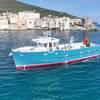Huntington Risks Losing $194 Million on Carrier’s Overrun
Huntington Ingalls Industries Inc. stands to loss as much as $194.3 million, more than 40 percent of its potential fee, under the Navy’s latest estimate of overruns for the USS Gerald R. Ford aircraft carrier, according to Bloomberg.
Construction of the Ford, the Navy’s most expensive warship, is likely to exceed by $884 million the shipbuilder’s target contract cost of about $5.2 billion for detailed design and construction, according to Navy officials and the service’s Selected Acquisition Report, obtained after it was delivered to Congress on March 29.
The Ford is intended to be the first in a $40 billion, three-ship class of carriers. Its rising costs have brought questions from Republican Senator John McCain about the Navy program and the shipbuilder’s performance. McCain of Arizona, a member of the Senate Armed Services Committee, has asked the Government Accountability Office for a review.
Huntington’s performance on costs “has stabilized, but has a long way to go to turn it around,” said Sean Stackley, the Navy’s assistant secretary for acquisition. The company and Navy aren’t in agreement on what the carrier’s final construction cost will be, he said.
Under the carrier contract, the Navy would pick up $689.7 million of the overrun now projected as “most likely,” with the remaining $194.3 million subtracted from potential maximum construction fees of $467 million for Huntington Ingalls of Newport News, Virginia. The carrier is about 40 percent complete.
The company would earn 50 cents of every dollar it shaves from the $884 million projection, Stackley said. If costs rise still further, “they are at a point in the contract where they share 50/50,” he said.
“We continue to see improvements in our performance on the carrier,” Huntington Ingalls spokeswoman Beci Brenton said. “Although this is a ‘first-in-class’ ship with unique challenges, we anticipate that we will increase efficiencies and continue to retire risk in the three years remaining until delivery.”
The Ford’s total projected cost has increased 18 percent in four years to $12.3 billion, from $10.4 billion, according to Navy budget figures cited by the nonpartisan Congressional Research Service. That includes systems which won’t be provided by Huntington Ingalls, such as the nuclear reactor to power the ship, a dual-band radar from Raytheon Co., and an electromagnetic aircraft-launching system from General Atomics of San Diego.
The Navy already has taken action against the shipbuilder. Last year, it didn’t let the company bill $75 million in fees because of the overrun projections, and that money has been forfeited, Stackley said.
Other cost-control initiatives include designating a Huntington senior vice president and a superintendent to oversee costs, specifying labor-cost targets and intensely reviewing specifications for the vessel, according to the Navy.
The latest overrun estimate stems from “material cost growth, labor inefficiencies” and increases in one-time engineering costs, according to the Navy document.
The labor “inefficiencies are the result of ‘first of class’ challenges,” including production issues, such as the use of thin-plate steel and weld distortion, the Navy wrote.
Huntington Ingalls “has had 10 consecutive months of improvements in meeting cost targets,” Rear Admiral Tom Moore, the Navy’s program executive officer for carriers, said in an interview.
“If they continue the trend they are on, I’m comfortable we will come in under the ’most likely’ $884 million estimate,” he said.
Still, he said, the company won’t meet the original targets.
On labor, the company is moving closer to the goal of 40 million man-hours on the carrier, from an earlier estimate of 53 million, Moore said. A man-hour is the work one person does in an hour.
“I need to drive them down further,” he said.
The company would receive the minimum fee allowed, about $196 million, if its performance deteriorates and the construction exceeds a worst-case overrun of $1.1 billion by completion in mid-2015, according to Stackley, who called that an unlikely outcome.
The minimum covers “a couple percent of profit and allowable costs,” he said.
The Navy disclosed in February that it was adding $811 million to the Ford’s budget through 2017 to cover increases, including $273 million directly tied to the construction overrun (Bloomberg).












